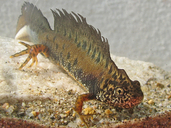|
Triturus dobrogicus (Kiritzescu, 1903)
Danube Crested Newt Subgenus: Triturus | family: Salamandridae subfamily: Pleurodelinae genus: Triturus |
 © 2006 Horia Bogdan (1 of 41) |
|
|
|
Description Distribution and Habitat Country distribution from AmphibiaWeb's database: Austria, Bosnia and Herzegovina, Bulgaria, Croatia, Czech Republic, Hungary, Moldova, Republic of, Romania, Serbia, Slovakia, Ukraine
The Danube Crested Newt lives in plain habitats with mixed deciduous forests and groves, bushlands, flooded meadows and swamps, including those in river valleys overgrown with large herbaceous and brush vegetation. The species also occurs in villages and agricultural landscapes. It reproduces in small ponds with stagnant water, oxbows, channels, ditches and flooded quarries. Life History, Abundance, Activity, and Special Behaviors In different parts of the range, migrations to breeding sites start from mid-February through April; sometimes a second migration to water occurs in autumn. Embryonic and larval development take about 2-2.5 months; metamorphosis has been recorded in July - early September and later. Adult and subadult individuals are known to stay in water for a long time, upto and beyond 6 months. Sometimes they do not leave the water before the first frosts: individuals frozen in ice were recorded from the Transcarpathian Plain. In captivity, metamorphosis and appearance of male secondary sex characters may occur in water. Trends and Threats Relation to Humans
References
Arntzen, J. W., Bugter, R. J. F., Cogalniceanu, D. and Wallis, G. P. (1997). ''The distribution and conservation status of the Danube Crested Newt, Triturus dobrogicus.'' Amphibia-Reptilia, 18, 133-142. Griffiths, R.A. (1996). Newts and Salamanders of Europe. T. and A. D. Poyser, London. Kuzmin, S. L. (1995). Die Amphibien Russlands und angrenzender Gebiete. Westarp Wissenschaften, Magdeburg. Kuzmin, S. L. (1999). The Amphibians of the Former Soviet Union. Pensoft, Sofia-Moscow. Litvinchuk, S. N., Rosanov, J. M. and Borkin, L. J. (1997). ''A contact zone between the newts Triturus cristatus and Triturus dobrogicus in the Ukrainian Transcarpathians: distribution and genome size variation.'' Herpetologia Bonnensis. W. Böhme, W. Bischoff, and T. Ziegler, eds., SEH, Bonn, 229-235. Nöllert, A. and Nöllert, C. (1992). Die Amphibien Europas. Franckh-Kosmos Verlags-GmbH and Company, Stuttgart. Szczerbak, N. N. and Szczerban, M. I. (1980). Zemnovodnye i Presmykayushchiesya Ukrainskikh Karpat [Amphibians and Reptiles of Ukrainian Carpathians]. Naukova Dumka, Kiev. Originally submitted by: Sergius L. Kuzmin (first posted 1999-10-06) Edited by: Sean Schoville (2021-01-26) Species Account Citation: AmphibiaWeb 2021 Triturus dobrogicus: Danube Crested Newt <https://amphibiaweb.org/species/4296> University of California, Berkeley, CA, USA. Accessed May 31, 2025.
Feedback or comments about this page.
Citation: AmphibiaWeb. 2025. <https://amphibiaweb.org> University of California, Berkeley, CA, USA. Accessed 31 May 2025. AmphibiaWeb's policy on data use. |




 Raffaëlli Account
Raffaëlli Account Map of Life
Map of Life